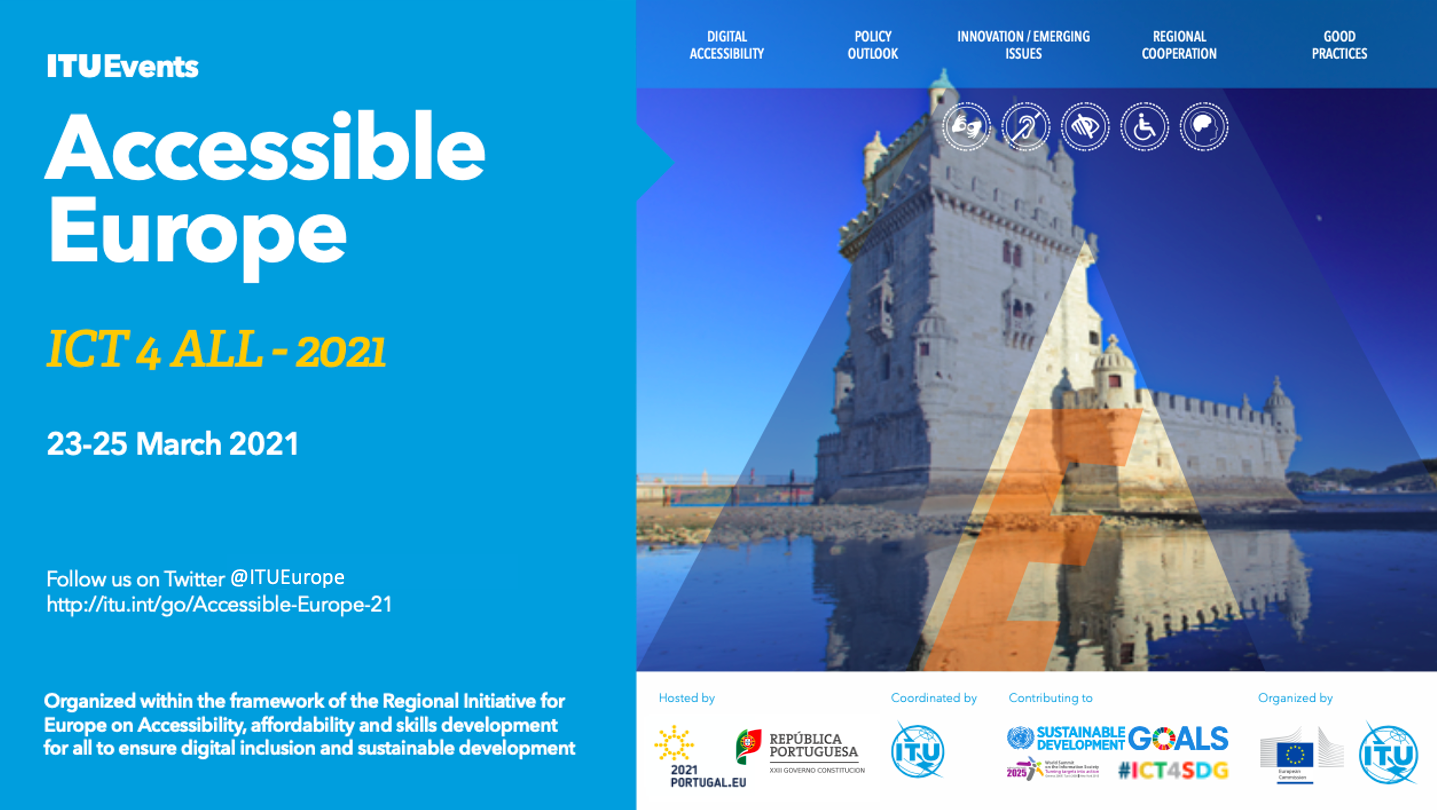
Accessible Europe is held yearly by the International Telecommunication Union (ITU) and the European Commission (EC) under the framework of the Regional Initiative for Europe on Accessibility, affordability and skills development for all to ensure digital inclusion and sustainable development. This regional initiative aims at bridging the digital divide and equipping all groups of society, including persons with disabilities and other groups of people with specific needs, to take advantage of ICT, by enabling capacity building in digital skills.
The event highlights yearly the relevance of joining efforts to remove barriers and enable human development and social inclusion of persons with disabilities and other groups of people with specific needs, through cooperation, programmes and projects development, generating partnerships, and training. The event also runs a competition looking for the best innovations out there in the area of accessibility. The event gathers hundreds of stakeholders working in this area.
Check out this year’s winners below and click on their links for more information:
o Visualfy
Visualfy is a sound recognition system that allows the adaptation of spaces for people with hearing loss. It is based on an artificial intelligence (AI) algorithm that recognizes sounds from the environment and transforms them into light alerts, shown in alert points distributed in space or user personal devices.
The idea was born 8 years ago when in a meeting in which I was the only non-deaf person, my phone rang vibrated on the table and the other deaf participants said "hey, they are calling you" and I explained that listeners have different types of notifications with different sounds (Facebook, Twitter, WhatsApp, etc.) and so from then on we realized that technology could really make a difference to cover countless needs for the deaf community.
It all started with an interview of the Dutch Minister of Health on national TV, in which he complained about “red tape" practices in home care, under which workers had to justify their time spending per five minutes. At that time, we were developing indoor positioning technology. While the Minister was talking, I had a flash of inspiration realizing that motion tracking could be used to assess the behaviour of people. This applied not only to the workers but even more so to the residents. Hence, the two faces of IANVS.
We jotted the idea down in an AAL (Active Assisted Living) proposal, an EU programme promoting digital solutions to help seniors living independently. We won the grant with flying colours and were sponsored by EU, VLAIO (Belgium), InnoSuisse (Switzerland) and PCT (Portugal) to work out IANVS. Of course, it took a few twists and turns during the last 2 years to arrive where we are now.
o Voiceitt
The idea and inspiration for developing Voiceitt came from personal experiences in the families of Voiceitt's founders. More than 10 years ago, Danny Weissberg (Voiceitt CEO)'s beloved grandmother had a stroke. She was the center of the family and after the stroke, she lost a lot of her motor abilities and independence. Her speech became unintelligible and when the family tried to communicate with her and could not understand her speech, Danny realized how painful it is to lose one's basic ability to communicate by voice.
This was the motivation to develop Voiceitt - a unique, leading AI speech recognition technology designed to recognize non-standard speech.
The inspiration for integrating Voiceitt with mainstream voice technologies came overwhelmingly from our community. Our company's early testing programs provided the opportunity for us to interact with and learn from hundreds of people with conditions affecting their speech, along with their families, speech and occupational therapists, and speech researchers around the world. We learned from these interactions that facilitating in-person communication (the reason we started this company!) is empowering and transformative, but in this new world of voice-enabled smart homes, smart cars, and smart assistants - all activated by voice - we could do a lot more: we could help people with non-standard speech access and interact with mainstream smart assistants and smart home devices, and thereby provide a whole new dimension and quality of life for our users.
The idea was born in 2016, when one of the investors suggested that our technological and business competencies should be transferred to another, previously undeveloped area, using VR. We were asked if it was possible to use VR goggles to treat eyesight, and we decided to take upon ourselves this challenge. After an in-depth analysis and mapping of the areas in which we can develop, as a result of cooperation with an external company, under our very detailed specification, the world's first medical VR goggles were created. For this project, we have created a 3-element system. The first element was the methodology consulted and developed with professors of pediatric ophthalmology such as prof. Prost, optometrists, and vision therapists. The second element was the software consisting of proprietary therapeutic exercises and a panel for the therapist, which could analyze the course of therapy and modify its parameters. The third element was equipment, i.e. specially designed VR goggles, which have medical certification, motion controllers, and a touch screen for qualified vision therapists to manage both in-office and home therapies. Sight rehabilitation using our VR glasses is the most modern method of treating strabismus, amblyopia and other problems of vision disabilities.
Source: International Telecommunication Union
 Welcome to the United Nations
Welcome to the United Nations